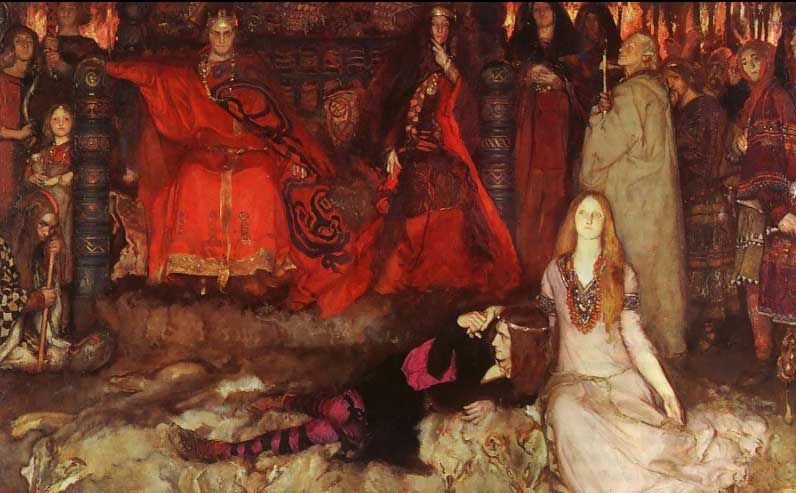Publication
Article
Psychiatric Times
Introduction: Why Does Psychiatry Need the Humanities?
Author(s):
Bringing the arts and humanities to psychiatry requires bringing these areas of study into our education, our research and our practice models.

Artist Edwin Austin Abbey: The Play Scene in “Hamlet” (Act III, Scene 2) 1897
© Yale University Art Gallery, Edwin Austin Abbey Memorial Collection.
The humanities counter psychiatry’s temptation to objectify patients. Reductionism is most often equated with “psychiatry’s relentless turn to bioscience,” which is fueled in part by pharmaceutical companies.1 But there are other sources of objectification. There is the bureaucratization of care, with the sometimes mindless applications of manualized treatments. And even during the heyday of psychoanalysis, psychiatrists too often rigidly applied their preexisting generalizations to patients rather than seeking to learn from them.
Literature, art, and other offerings of the humanities counter reductionism by confronting us with each person’s subjectivity and individuality. Whether reading Joyce’s “The Dead,” viewing Van Gogh’s “Starry Night,” or listening to Hamlet’s soliloquys, we imagine ourselves into an experience, a mood that illuminates each of our own subjectivities. There is irony in the words “our subjectivities”-“our” implies a shared experience, yet the experience is about the self. The humanities, like good psychotherapy and subtle biologic psychiatry, must rely on working generalizations, but they do so in the service of understanding the individual.
This Special Report includes 4 fresh approaches to bringing humanities into psychiatry: one seeks to transcend the schism between biological and psychodynamic approaches; another illustrates the power of visual art to transform stigma; a third suggests that Shakespeare’s Hamlet carries wisdom missing from forensic psychiatry; a fourth argues for the therapeutic potential of a spirituality religiosity assessment. To supplement these approaches, we briefly discuss 2 other areas in which the humanities and psychiatry have powerful links-philosophy and narrative theory.
Philosophy reminds us of the limits of our knowledge. For example, Donald Davidson2 shows us that no amount of physical description can explain mental events. By definition, mental events are delineated in terms of reasons or intentions. Physical descriptions can explain physical causation but not mental causation.
This does not mean that neuroscience cannot offer powerful accounts of mental illness, but it does mean that linking mind and brain accounts will be challenging. We need to think more critically about how we conceptualize both the brain and the mind. We need to distinguish metaphors from valid arguments. For example, while “mirror” neurons tell us something important about our capacity for motor and sensory mimicry, they do not explain empathic curiosity.
Philosophy can also help psychiatrists refine their understanding of this empathic curiosity. Empathic curiosity is different from the kind of curiosity that motivates us to consider differential diagnoses and medical science. Scientific curiosity seeks descriptive knowledge-to know more about why some people become schizophrenic, to know whether a patient is demoralized or clinically depressed.3
In contrast, empathic curiosity is an interest in “knowing how.”4 It takes a quasi–first-person perspective toward the patient’s predicament. Absent empathic curiosity, our scientific curiosity to seek the correct diagnosis makes us like weather forecasters-is it going to snow? Empathic curiosity adds to this an interest in what the snow feels like for this patient.4 Rita Charon5 shows that we can teach empathy by teaching young physicians to write patient narratives from an imagined first-person perspective. The promise of the humanities here is to revive our interest in our patients’ experiences.
Patients tell us about their experiences through stories; psychiatrists spend more time listening to these stories than they spend doing anything else. Until recently, however, psychiatrists have had few resources beyond their own clinical writings for understanding these clinical stories. Fortunately, the study of narrative has grown exponentially in the past few decades, and narrative is now a key topic across the academic worlds of literary theory, philosophy, anthropology, cultural studies, and religious studies. And, narrative is increasingly important in the clinical domains of narrative medicine and narrative psychotherapy.
This ferment of interest in narrative has opened the door for the development of narrative approaches to psychiatry.6 This development provides a critical corrective to contemporary practice and helps bring psychiatry back to the human dimensions of psychiatric care. However, this corrective does not supplant psychodynamics, nor does it demolish the developments of scientific psychiatry. When psychiatrists take a narrative turn, they do not throw out their other skills and knowledge. The shift to narrative is, as much as anything else, attitudinal and an opening to additional sources of information. It starts by bringing to the foreground the concept that the clinical encounter is a human one, and it includes colleagues from the humanities, interpretive social sciences, and the arts who help us better understand this human encounter.
Bringing the arts and humanities to psychiatry requires bringing these areas of study into our education, our research, and our practice models. This does not mean that we should let go of neuroscience, genetics, or evidence-based treatments. It does not even mean giving up our white coats or our stethoscopes. It simply means that adding to our empirical knowledge base resources from the arts and humanities will expand the human side of our practice. The arts and humanities can mightily help us prepare for the most human moments of clinical care.
References:
1. Lewis B. Narrative and psychiatry. Curr Opin Psychiatry. 2011;24:489-494.
2. Davidson D. Mental events. In: Foster L, Swanson JW, eds. Experience and Theory. Amherst, MA: University of Massachusetts Press; 1970.
3. Ryle G. The Concept of Mind. Chicago: University of Chicago Press; 1949.
4. Halpern J. From Detached Concern to Empathy: Humanizing Medical Practice. New York: Oxford University Press; 2001.
5. Charon R. Narrative and medicine. N Engl J Med. 2004;350:862-864.
6. Lewis B. Narrative Psychiatry: How Stories Can Shape Clinical Encounters. Baltimore: Johns Hopkins University Press; 2011.






